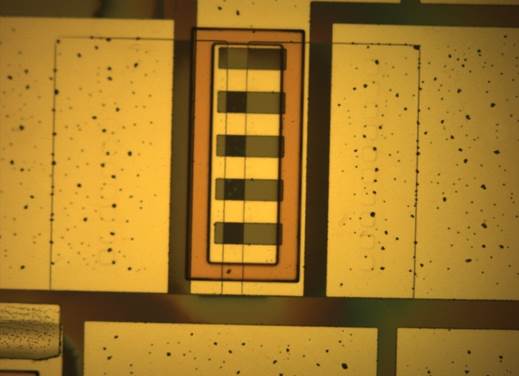
He suspects that such semiconductors could replace nerves in the body that have been damaged by disease or injury.
New technology under development at The Ohio State University is paving the way for low-cost electronic devices that work in direct contact with living tissue inside the body.
The first planned use of the technology is a sensor that will detect the very early stages of organ transplant rejection.
Paul Berger, professor of electrical and computer engineering and physics at Ohio State, explained that one barrier to the development of implantable sensors is that most existing electronics are based on silicon, andelectrolytes in the body interfere with the electrical signals in silicon circuits. Other, more exotic semiconductors might work in the body, but they are more expensive and harder to manufacture.
“Silicon is relatively cheap… it’s non-toxic,” Berger said. “The challenge is to bridge the gap between the affordable, silicon-based electronics we already know how to build, and the electrochemical systems of the human body.”
In a paper in the journal Electronics Letters, Berger and his colleagues describe a new, patent-pending coating that that they believe will bridge that gap.
In tests, silicon circuits that had been coated with the technology continued to function, even after 24 hours of immersion in a solution that mimicked typical body chemistry.
The project began when Berger talked to researchers in Ohio State’s Department of Biomedical Engineering, who wanted to build an insertable sensor to detect the presence of proteins that mark the first signs of organ rejection in the body. They were struggling to make a working protein sensor from gallium nitride.
“We already have sensors that would do a great job at detecting these proteins, but they’re made out of silicon. So I wondered if we could come up with a coating that would protect silicon and allow it to function while it directly touched blood, bodily fluids or living tissue,” Berger said.
The Latest Bing News on:
Implantable Electronics
- Thiol-ene click reaction offers a novel approach to fabricate elastic ferroelectricson April 26, 2024 at 6:23 am
A research group led by Prof. Li Runwei and Hu Benlin at the Ningbo Institute of Materials Technology and Engineering (NIMTE) of the Chinese Academy of Sciences has developed a facile and efficient ...
- Contemporary Management of Cardiovascular Implantable Electronic Device Infectionson April 25, 2024 at 5:00 pm
Empiric antimicrobial therapy should be directed against staphylococci. Due to rising methicillin resistance in staphylococci, vancomycin should be administered while awaiting culture results ...
- Rubber-like stretchable energy storage device fabricated with laser precisionon April 24, 2024 at 1:21 pm
Researchers have achieved a significant breakthrough in developing a small-scale energy storage device capable of stretching, twisting, folding, and wrinkling. Their study is published in the journal ...
- Global Implantable Infusion Pump Industryon April 24, 2024 at 9:05 am
Global Implantable Infusion Pump Industry is projected to reach a valuation of US$ 485.1 Mn in 2022, to surge at a 5.7% CAGR By 2032 ...
- Automotive Electronicson April 23, 2024 at 5:00 pm
Recom has created a chassis-mount isolated dc-dc converter for nominal battery voltages from 24 to 90V. Called RMOD360-UW, it can deliver full power continuously with inputs between 27 and 106V, as ...
- Vietnam Printed Electronics Market Latest Trends, Segmentation Analysis, Share, Size, and Forecast 2024 to 2032on April 17, 2024 at 3:09 pm
The recent analysis by Report Ocean on the “Vietnam Printed Electronics Market” Report 2024 to 2032 revolves around various aspects of the market, including characteristics, size and growth, ...
- Cook Medical Awarded Defense Contract for Zilver PTX Stent, Zenith Endograft, and Other Interventional Deviceson April 11, 2024 at 9:29 am
According to Cook Medical, the contract includes the company’s Zilver PTX drug-eluting peripheral stent, Zenith aortic endograft, and associated interventional devices to treat patients with vascular ...
- Implantable battery could run on the body's own oxygenon April 2, 2024 at 10:33 pm
"Implantable electronics have transformed disease diagnostics, therapies, wound healing, and health monitoring," wrote the researchers. "The reliable operation of these devices depends on the ...
- Long-distance and low-attenuation magnetic energy focusing technology for deep-tissue wireless poweringon April 2, 2024 at 4:59 pm
Fully implantable electronic devices such as cardiac pacemakers, cardiovascular monitors and deep brain stimulators, have been widely developed in medical monitoring, diagnosis, and treatments.
- Acids enable adhesive electrodes for thin, flexible supercapacitorson March 31, 2024 at 5:00 pm
Researchers can use different materials and fabrication methods to make them flexible, thin and appropriate for use in wearable or implantable electronics, like smart watches or pacemakers ...
The Latest Google Headlines on:
Implantable Electronics
[google_news title=”” keyword=”Implantable Electronics” num_posts=”10″ blurb_length=”0″ show_thumb=”left”]
The Latest Bing News on:
Fix the internet
- How short films helped launch the careers of these famous directorson April 27, 2024 at 7:00 pm
Everybody has to start somewhere, even huge directors like Christopher Nolan and Denis Villeneuve have short films that helped launch their careers.
- The 10 worst changes to stock Androidon April 27, 2024 at 8:00 am
From fooling around with the power button to the Internet tile, not all of Google's changes to Android were great.
- Taylor Swift Exposes the Dark Side of Music Criticismon April 27, 2024 at 5:00 am
Connecting decision makers to a dynamic network of information, people and ideas, Bloomberg quickly and accurately delivers business and financial information, news and insight around the world ...
- How to fix the ‘Not Registered on Network’ error on a Samsung Galaxy phoneon April 27, 2024 at 3:01 am
Have a Samsung phone? Seeing an annoying Not Registered on Network error and unsure what to do about it? Here's everything you need to know to fix it.
- Two arrested for theft of AT&T cable that took down internet hereon April 27, 2024 at 1:33 am
Adams County Sheriff’s Deputies responded to a call at approximately 11 a.m. Friday concerning the theft of AT&T internet cables from a location on Powell Road. The cable had been cut and stolen.
- How to Fix the "No Internet Secured" Error on Windowson April 26, 2024 at 8:00 am
The message "No Internet, Secured" usually appears when your connection is weak. You can reboot your router to refresh your network, which might also improve its speed. Alternatively, you can also ...
- How to Fix Search Results in the Windows 11 Start Menuon April 24, 2024 at 3:01 pm
Windows 11's start menu, by default, searches the internet and your computer at once. Here's how to keep things local.
- Algorithmic Curation Is Ruining The Internet. Here's How to Fix Thaton April 24, 2024 at 6:00 am
Machine learning researchers at Stanford have developed an innovative way to moderate online content—one that could potentially make the web less polarizing and divisive.
- Internet For Gaming: The Best NBN Plans To Help Fix Your Pingon April 23, 2024 at 9:57 pm
If your lagging is getting out of hand, you might be looking into finding the right internet for gaming. Here are our top tips and ISPs.
- Forward Thinking: Can feminism fix the internet?on April 23, 2024 at 5:37 pm
Dr Kerry McInerney is a research fellow at the Leverhulme Centre for the Future of Intelligence, University of Cambridge, and the AI Now Institute. This is the last of four programmes from the Oxford ...
The Latest Google Headlines on:
Fix the internet
[google_news title=”” keyword=”fix the internet” num_posts=”10″ blurb_length=”0″ show_thumb=”left”]











